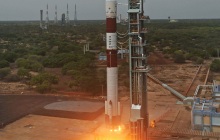India’s PSLV Rocket Lofts Airbus Spot 7
India’s PSLV rocket successfully placed Airbus’ Spot 7 commercial Earth observation satellite into Orbit June 30 along with four smaller satellites belonging to Germany, Canada and Singapore.
Spot 7 separated from the rocket 18 minutes after launch and went into a 660-kilometer orbit; the other four satellites were deployed over the next two minutes, according to the Indian Space Research Organisation.
India’s new prime minister, Narendra Modi, described the nationally televised launch as a “global endorsement of India’s space capability. We must keep enhancing our capability in all areas of space technology and build heavier satellites and new launch infrastructure,” Modi said.
The 714-kilogram Spot 7 satellite built by Europe’s Airbus Defence & Space was the main passenger on PSLV’s latest flight. The co-passengers were the German Aerospace Center’s 14-kilogram AISat-1; a pair of identical Canadian Advanced Nanospace eXperimental satellites — CanX-4 and CanX-5 — each weighing 15 kilograms and built by the Toronto Institute for Aerospace Studies’ Space Flight Laboratory; and Singapore’s 7-kilograms Velox-1 satellite designed and built by students of Nanyang Technological University.
ISRO said all five satellites were launched under commercial contracts brokered by Antrix, ISRO’s commercial arm. Financial terms were not disclosed.
Spot 7, designed to last 10 years, joins the Spot 6 satellite placed into orbit by a PSLV in September 2012. Airbus Defence and Space said in a statement that the successful launch of Spot 7 complete its constellation of high-resolution Earth imaging satellites. In addition to the Spot satellites, Airbus also has exclusive commercial use of the French civil-military Pleiades 1A and Pleiades 1B satellites flying in the same orbit.


 2602
2602
 48
48

 52
52
 2
2